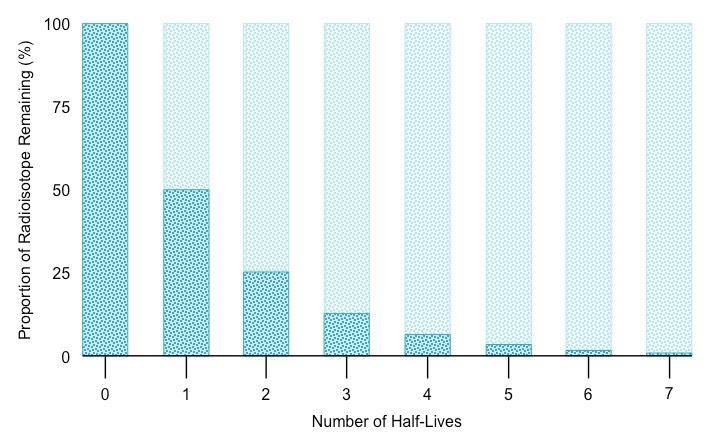One of the most commonly used methods for determining the age of fossils is via radioactive dating (a.k.a. absolute dating)
- This method involves comparing the ratio of radioactive isotopes in the fossil to that found in the atmosphere today
Radioisotopes are alternative forms of an element that have the same number of protons but a different number of neutrons
- These isotopes are unstable and decay at a constant rate to form a more stable daughter isotope
There are three types of radioactive decay that can occur (depending on the radioisotope involved):
- Alpha decay – Atom releases two protons and two neutrons (alpha particle) to form a new, more stable element
- Beta decay – A neutron decays to produce a proton, electron and anti-neutrino (electron is released and a new element forms)
- Gamma decay – Involves the release of electromagnetic radiation (gamma rays), but does not change the mass of the atom
Alpha radiation can be stopped by paper, beta radiation can be stopped by wood, while gamma radiation is stopped by lead
Types of Radioactive Decay

Half Life
Radioisotopes decay at a constant rate and the time taken for half the original radioisotope to decay is known as the half life
- Different radioisotopes have different half lives and are thus useful for dating different types of fossilised remains
Short Range Dating
- All living things contain carbon and this carbon exists as a mix of two isotopes – 12C (stable) and 14C (radioactive)
- While alive, the proportion of the two isotopes will mirror environmental levels (as carbon is constantly being cycled)
- When an organism dies, the ratio no longer remains fixed but changes as 14C breaks down into 14N (beta decay)
- Scientists can measure the amount of 14C remaining in a sample to determine how long ago it died
- 14C has a half life of only 5,730 years and so can only effectively date samples less than ~60,000 years old
Long Range Dating
- Longer range dating can be accomplished by dating the rocks around the fossil to determine an age range (relative dating)
- Dating can only be undertaken on igneous rock, not the fossils themselves or the sedimentary rock in which they are found
- 40K is released in lava from active volcanos and decays into 40Ar with a half life of approximately 1.3 billion years
- Using the volcanic eruption as an indicator of when a rock layer (strata) developed, the age of the fossil can be approximated
- As 40Ar is inert and would have been released as a gas during the eruption, its levels in the rock indicate radioactive decay
Radioactive Decay Curve


⇒ Click on the diagram to show the proportion of radioisotope remaining
Other Dating Techniques
While radioisotope dating is the most commonly used method for dating fossils, other techniques do exist
- These other techniques include relative dating via index fossils and electron spin resonance (ESR)
Index Fossils
- The earth is arranged into sedimentary layers (stratification) with older stratum at the bottom and newer layers on top
- Different regions will not always have the same sedimentary layers due to environmental conditions (erosion, flooding, etc.)
- Index fossils represent short-lived species and thus can only be found in a restricted depth of rock strata
- Index fossils can be used to synchronise the ages of rock layers when other dating techniques are not available
Electron Spin Resonance
- Electron spin resonance (ESR) is a useful dating tool for organic samples that are aged between 50,000 – 500,000 years old
- ESR depends on the fact that when objects are buried they are bombarded by natural radiation from the soil
- This causes the electrons in minerals to move to (and remain in) a higher energy state
- The number of high energy electrons in a sample can be used to determine when the sample was buried
